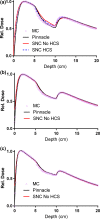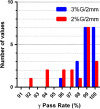Validation of a GPU-Based 3D dose calculator for modulated beams
- PMID: 28371377
- PMCID: PMC5689856
- DOI: 10.1002/acm2.12074
Validation of a GPU-Based 3D dose calculator for modulated beams
Abstract
A superposition/convolution GPU-accelerated dose computation algorithm (the Calculator) has been recently incorporated into commercial software. The algorithm requires validation prior to clinical use. Three photon energies were examined: conventional 6 MV and 15 MV, and 10 MV flattening filter free (10 MVFFF). For a set of IMRT and VMAT plans based on four of the five AAPM Practice Guideline 5a downloadable datasets, ion chamber (IC) measurements were performed on the water-equivalent phantoms. The average difference between the Calculator and IC was -0.3 ± 0.8% (1SD). The same plans were projected on a phantom containing a biplanar diode array. We used the forthcoming criteria for routine gamma analysis, 3% dose-error (global (G) normalization, 2 mm distance to agreement, and 10% low dose cutoff). The γ (3%G/2 mm) average passing rate was 98.9 ± 2.1%. Measurement-guided three-dimensional dose reconstruction on the patient CT dataset (excluding the Lung) resulted in a similar average agreement rate with the Calculator: 98.2 ± 2.0%. The mean γ (3%G/2 mm) passing rate comparing the Calculator to the TPS (again excluding the Lung) was 99.0 ± 1.0%. Because of the significant inhomogeneity, the Lung case was investigated separately. The calculator has an alternate heterogeneity correction mode that can change the results in the thorax for higher-energy beams (15 MV). As this correction is nonphysical and was optimized for simple slab geometries, its application leads to mixed results when compared to the TPS and independent Monte Carlo calculations, depending on the CT dataset and the plan. The Calculator vs. TPS 15 MV Guideline 5a IMRT and VMAT plans demonstrate 96.3% and 93.4% γ (3%G/2 mm) passing rates respectively. For the lower energies, which should be predominantly used in the thoracic region, the passing rates for the same plans and criteria range from 98.6 to 100%. Overall, the Calculator accuracy is sufficient for the intended use.
Keywords: GPU-accelerated calculations; convolution/superposition; dose calculations; segmented beams.
© 2017 The Authors. Journal of Applied Clinical Medical Physics published by Wiley Periodicals, Inc. on behalf of American Association of Physicists in Medicine.
Figures






References
-
- ACR ASTRO Practice guideline for intensity modulated radiation therapy (IMRT). 2011. http://www.acr.org/~/media/ACR/Documents/PGTS/guidelines/IMRT.pdf accessed 01/25/2017.
-
- Stern RL, Heaton R, Fraser MW, et al. Verification of monitor unit calculations for non‐IMRT clinical radiotherapy: report of AAPM Task Group 114. Med Phys. 2011;38:504–530. - PubMed
-
- Low DA, Moran JM, Dempsey JF, et al. Dosimetry tools and techniques for IMRT. Med Phys. 2011;38:1313. - PubMed
-
- van Elmpt W, McDermott L, Nijsten S, et al. A literature review of electronic portal imaging for radiotherapy dosimetry. Radiother Oncol. 2008;88:289–309. - PubMed
-
- van Elmpt W, Nijsten S, Mijnheer B, et al. The next step in patient‐specific QA: 3D dose verification of conformal and intensity‐modulated RT based on EPID dosimetry and Monte Carlo dose calculations. Radiother Oncol. 2008;86:86–92. - PubMed
Publication types
MeSH terms
LinkOut - more resources
Full Text Sources
Other Literature Sources
Research Materials

